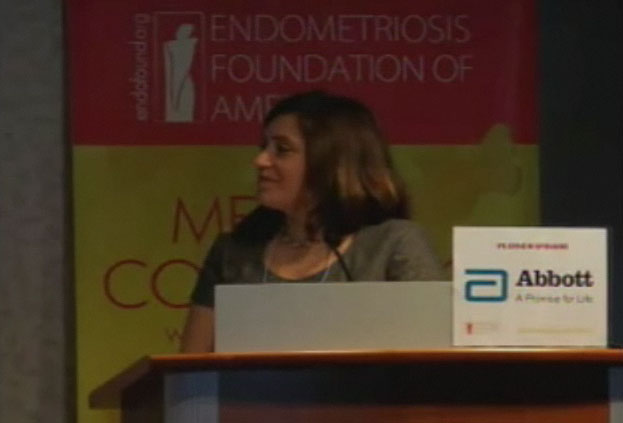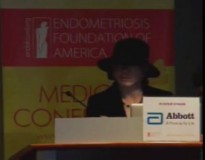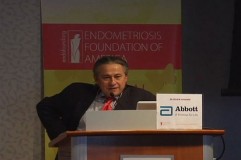Endometriosis Foundation American: Medical Conference – 2010
Pinar H. Kodaman
Thank you for the opportunity to speak here today. I am going to talk about angiogenesis, both in the normal endometrium and in endometriosis, and compare and contrast how that process goes awry when we go from a normal physiological state to a path of physiological situation.
What is angiogenesis? It is the process by which new blood vessels are formed from pre-existing vessels. As this diagram here shows, it is a process that is tightly regulated, as you might imagine, and basically endothelial cells, which lie in the blood vessels, are usually in a quiescent state until they get a signal from a growth factor; for example to start proliferating, and then migrating, and then forming these sprouts and eventually tubes that are vessels arising from pre-existing vessels. Once the initial neo-vessel is formed, then it is required to stabilize and that involves the recruitment of mural cells or pericytes, and vascular muscle cells, which basically stabilize the vessel and allow it to be sustained. We will come back to that later.
As I alluded to, there are two types of angiogenesis. There is the physiologic, which first occurs during growth and development, and this is more appropriately known as vascular genesis, the generation of blood vessels in the embryo for example. In the adults there are very few tissues, mostly confined to the female reproductive tract that undergo physiologic angiogenesis, namely the endometrium, and of course the corpus luteum, and placenta during pregnancy. Another case of physiologic angiogenesis is wound healing. Pathologic angiogenesis is common with tumors that is how they grow and spread and metastasize, and also in other medical conditions, such as diabetic retinopathy, and we are here today to discuss endometriosis, of course.
There are a lot of theories about endometriosis and how it starts, why some people are more susceptible to it than others. Regardless of which of these theories you believe, angiogenesis is an important part of the pathophysiology of this disease. You can see here as Dr. Seckin also showed, these lesions are very well vascularized and invasion and implantation of these lesions does require the process of angiogenesis. To understand aberrant angiogenesis, we have to understand how angiogenesis normally occurs in the endometrium, as it is the endometrial tissue that implants to form endometriosis implants. Angiogenesis occurs in all stages of the menstrual cycle. During menses, after the functionalis layer is shed it is the basalis layer with its vessels that have to be repaired. This is a period of most intense angiogenesis. That is over here.
Subsequently, during the proliferative phase, what happens is the elongation of vessels, which you see here, in response mostly to estrogen. When we get to the secretory phase after ovulation and production of progesterone, it is not really elongation but maturation, intussusceptions, which basically refers to a branching of the vessels that you see here, that occurs in the secretory endometrium. There are probably hundreds of now well characterized mediators of angiogenesis in the endometrium.
We obviously do not have time to discuss all of them today, but I just wanted to touch upon a few for which there are data, and we will focus on even fewer. Ovarian sex steroids of course are important for endometrial angiogenesis. As I mentioned, estrogen is required for proliferation and growth of the vessels, progesterone more so for formation of the spiral arteries in the endometrium, also for vessel maturation. There are also numerous growth factors, including vascular endothelial growth factor, fibroblast growth factor, platelet-derived growth factor, and many others that formed the initial stimulatory signal for the quiescent endothelial cells to start proliferating and forming new vessels.
Leukocytes, or white blood cells also mediate this process. If you make a woman neutropenic, or lower the white blood cell count, endometrial proliferation will be blocked. There are various inflammatory mediators that mediate this process. Hypoxia, or a lack of oxygen, also stimulates angiogenesis and this hypoxia inducible factor is one of the most potent stimulators of vascular endothelial growth factor, which is the main mediator of angiogenesis in endometrium. Then of course there are stem cells, which Dr. Taylor will talk about, and an area that is of interest to me in terms of my research is microRNAs in angiogenesis. This is a budding field that is just becoming interesting in looking at endometrium and endometriosis. I will not talk too much about that today, but I am sure in the next couple of years it will be shown to have a clear role. The most well characterized growth factor in endometrial angiogenesis is the vascular and epithelial growth factor, and there is a whole family of these. VEGFA is the main isoform in human endometrium, but as you can see there are many others. This molecule binds to the VEGF receptors which are expressed on the cell surface of endothelial cells, and there are different types of receptors that this compound can find, which results in dimerization, and then subsequently activation of downstream signaling to cause endometrial cells to proliferate, migrate and form tube structures.
What do we know about VEGF and the endometrium? Well VEGFA mRNA, which is the signal to make the protein, is highly expressed by endometrial epithelium as well as stroma. It is regulated by the ovarian sex steroids and is expressed in both the temporal and spatial fashion. The highest expression is during menses, which is as I mentioned is the most active period of endometrial angiogenesis. It is regulated by estrogen more than progesterone. Progesterone has a smaller, sort of a slower onset of action with respect to inducing this growth factor. If we look at the receptors, both VEGF receptor 1 and receptor 2, are expressed in endometrium. They also are regulated by the sex steroids, estrogen and progesterone. The activation of the VEGF receptor 2 is highest in the late menstrual phase when angiogenesis is most active and it remains active in a lower but sustained fashion during the proliferative phase.
Now let us talk about endometriosis and angiogenesis. As I showed you in one of the first slides, endometriosis is often surrounded by a web of neo-vessels as you can see here. Often times when we look surgically we see basically a hypervascular peritoneum. There are lots of vessels and lots of what appears to be inflammation as you can see here.
When we look under the microscope, that confirms a high vascular density in these tissues. Interestingly, extra pelvic endometriosis, i.e. endometriosis out of the pelvis, occurs in very well vascularized organs such as the lung, which you see here. It can also occur in the diaphragm, in the bowel and other areas where the vessel density is high, and it allows for these implants to stick and then make new vessels. The mechanisms of angiogenesis and endometriosis are not completely understood, but there are three general mechanisms that are proposed: the sprouting of vessels as I showed you in the introduction and elongation, intussusceptions, which is a branching of vessels, as well as vessel maturation, which is the recruitment of those cells to really stabilize and support the new vessels, so that they can survive.
When we look at the angiogenic factors that are expressed in endometriosis, they are very similar, probably not surprisingly, to those that are over expressed in tumors or cancers. We have a whole list, which I will not go through for the sake of time, but VEGF receptors are among them, and the matrix metalloproteinases which degrade the basement membrane around the vessels allow them to sprout. If you look at it overall, there is an imbalance of the angiogenic to the anti-angiogenic factors so that there is a dysregulation that allows for sprouting of new vessels in an uncontrolled fashion.
When we look at vascular endothelial growth factor in endometriosis, we note that the concentrations are highest in those hemorrhagic pink or red lesions, usually the earlier lesions. There are also higher concentrations of soluble vascular endothelial growth factor in the peritoneal fluid of patients with advanced endometriosis, stage III, stage IV disease. The local environment in these patient's pelvises are notable for increased hypoxia, acidosis, leukocyte infiltration, all things that are going to increase the production of VEGF, macrophages themselves will increase VEGF production.
That is shown here. These are the red, really hypervascular lesions. This is a more established lesion. If you look at the white lesions, they are also vascularized. You cannot see it as much, they are deeper, more mature vessels within these. If we look at late endometriosis, like this is deep invasive rectovaginal endometriosis, the cul-de-sac is actually obliterated and the vessels are very mature and deep inside. The vessels translate into increased blood flow too as you might imagine. If you look at endometrium, as in patients with endometriosis, these have increased blood flow and that correlates to their degree of pelvic pain. Similarly, the deeply invasive rectovaginal disease that I showed you in the previous slide is also associated with increased microvascular density. We are just beginning to understand the role of vessel density and pain. It is thought that perhaps the same growth factors that encourage the vessels to grow into these lesions, are also helping to stimulate the growth of nerve fibers and causing the pain symptoms to arise.
Just to end in the last few minutes, I want to touch upon antiangiogenic therapy as a potential therapeutic agent for endometriosis. GnRH analogues, such as leuprolide acetate and progestins, are well known to decrease endometriosis implant size in part, for a lot of reasons, but also in part due to decreasing the angiogenesis. More recently people are beginning to look at other compounds such as thalidomide, which actually inhibits one of the interleukins that stimulates angiogenesis. Women with endometriomas were given six months of this drug combined with a GnRH analogue. This is just a pilot study, but one of the few clinical studies on antiangiogenic therapy on endometriosis and eight out of 10 women actually improved. Of course thalidomide has a well established teratogenicity so we have to use it with extreme caution in women of reproductive age.
There are many animal studies looking at antiangiogenic therapies, whether stimulating antiangiogenic factors or blocking angiogenic factors, which we do not have time to go into. In one of the more recent studies, we actually looked at blocking the receptor activation for VEGF, for FGF and PDGF, which are the growth factors that I mentioned. You can see in the control here, these are hamsters that were implanted with their own endometrium in the dorsal skin folds, and then neovascularization was looked at up to two weeks later. You can see in the control, there is significant neovascularization, but when the animals were treated with inhibitors of the receptors, the vascularization is limited with areas here that are black, and shown by the asterisk that have no angiogenesis at all, and that is recapitulated here in the graph below.
Basically in this study when you blocked all three growth factor receptors, you got a significant effect, but that’s not to be due to the fact that if you just block VEGF, you’re blocking neoangiogenesis. But if you block the other receptors, you are also blocking the established vessels. A more recent study from Spain looked at the use of a dopamine agonist, which we commonly use to treat patients with hyperprolactinemia and Parkinson's. This agonist basically as a side effect also blocks VEGF Receptor 2 activation and you can see here in the control animal there are significant neovascularisation., whereas with low and high-dose of this medication, the animals had decreased proliferation and decreased neovascularization of their endometriosis implants. These were human endometrium implanted into basically an immune compromised mouse.
There are challenges of antiangiogenic therapy of course. As we have seen that most of the studies are in animals, we are still a long way from good clinical trials. Again the therapy mostly targets only new vessels so that does not take care of the well established diseases, deep infiltrating lesions, large endometriomas et cetera. The problem of course is that endometriosis is commonly diagnosed late. There is a delayed diagnosis, sometime six years or more. We do not often catch the early lesions that antiangiogenic agents can help with. Of course we have to worry about inhibiting physiologic angiogenesis when we are treating women with these compounds, and of course they would therefore be contraindicated in pregnancy where we need angiogenesis to occur for placentation.
Some new targets are vascular disrupting agents, which are used mostly for cancer therapy. Basically this targets established vessels by using peptide or viruses or even nanoparticles to deliver a toxin specifically to the vessels of interest. People have even begun to look at vaccination with endothelial cell markers to cause a regress in angiogenesis, and this has actually been done not only in cancer models, but also with endometriosis models. Eventually I think we will see microRNAs coming to the forefront of this type of therapy.
To end in terms of future directions, we need to better understand both physiological angiogenesis as well as pathologic in the setting of endometriosis. We need to characterize the differences better between women who have endometriosis, and those who do not, in terms of their endometrium and their local peritoneal milieu, and what makes them more susceptible to the disease. We need to focus of course on the early diagnosis of endometriosis. The clinical trials of antiangiogenic agents, or vascular disrupting agents, I think are going to be the wave of the future. Keep in mind, we may need to combine drugs such as hormones as well as these antiangiogenic drugs to be able to really get a handle on this very complex disease.
And with that, I will end. Thank you.










